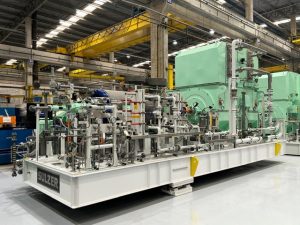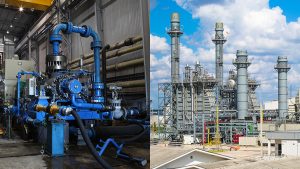Tackling Inefficiency Through Cost-Effective Solutions for Pumps and Mixers

AHLSTAR A end-suction single-stage centrifugal process pump. (Image source: Sulzer Ltd.)
Several options can be available and with energy prices reaching new heights, the return on investment is rapidly reducing. Saku Vanhala, Head of Product Management at Sulzer, looks at how equipment operators can make positive changes to improve efficiency and help to meet corporate goals in sustainability.
Energy efficiency is becoming increasingly important in industry applications due to rising energy costs. Improving pump and agitator performance can result in substantial savings, both in terms of reducing energy consumption and operational costs. The key to improving energy efficiency is matching the design of the pump, installation, process conditions, and operation to each other and taking into account any changes to process parameters that may have occurred over time.
Huge saving potential
With increasing demand, combined with global price rises, energy usage and how to reduce it, is rapidly becoming a priority for all countries. Among several initiatives, many governments are also supporting businesses with grants to upgrade equipment to more energy-efficient alternatives, to help reduce demand on national power grids.
Pump operators should have access to pump data and performance curves, which can be used to calculate current efficiency levels and identify areas for improvement. An expert appraisal of the pump can also provide information on the remaining service life of the pump and help make an informed decision on the best course of action to improve performance.
The most significant savings in energy consumption can be achieved by selecting the most appropriate pump technology for the application and optimizing the pump size. Using variable speed drives (VSDs) can also improve efficiency, allowing the rotational speed of the pump to be adjusted for optimal performance. Considering the use of control valves can also result in significant energy savings.
Retrofit improvements
For larger pumps, retrofitting is often the most cost-effective method of improving performance. This can involve modifying the impellers to optimize hydraulic performance, enabling the pump to operate at the best efficiency point (BEP). For smaller pumps, it may be more cost-effective to replace existing assets with modern, more efficient, and reliable equivalents.
Aside from the pumps, agitators and mixers are used in many industrial processes and can be overlooked in terms of the potential savings they can achieve by optimizing their performance. All too often, they can be over-specified or operated beyond the point where optimal mixing has been achieved. In these situations, energy can be saved and operating costs reduced.
In combination with its industry leading pump designs, Sulzer also has a wide range of highly efficient mixers and agitators. Even better, the latest designs of SALOMIX propellers can be retrofitted to older models to improve hydraulic efficiency, reducing running costs. Depending on the application, replacing the MX4 propeller with the new, high-efficiency EX3 propeller can save up to 20% in power consumption.
Savings through digital solutions
In addition to upgrading existing equipment, further savings can be achieved by introducing intelligent process control and optimization tools. Wireless sensors that are attached to a pump, agitator, motor, or any rotating equipment can measure temperature and vibration and send the data to the cloud. This enables the operating status of the equipment to be remotely monitored 24/7 and planned maintenance to be scheduled more accurately.
It is also important to look beyond the equipment and focus on the pipework and control valves as well. It is often the case that valves have been used to throttle flow from a pump to suit the process. This means that energy is being wasted all the time that the pump is operating. Improving the pipework layout and flow control devices surrounding the pump can make significant reductions in energy consumption.
With rising energy costs, the priorities of the key performance indicators (KPIs) within a company may need to change. Existing equipment should be assessed for efficiency and reliability, with options to achieve the best improvements. Buying decisions need to be based on the long-term savings that can be achieved and the time in which the investment will be recovered. If the focus throughout the business is targeted on improving energy efficiency, then major savings can be achieved while also meeting corporate goals in sustainability.
Source: Sulzer Ltd.







